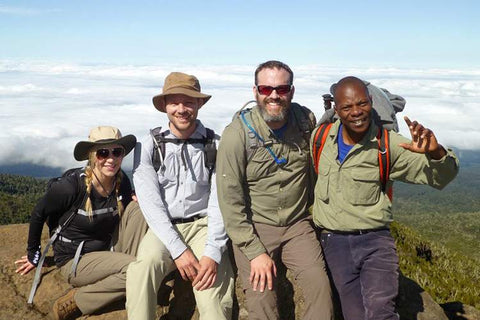SOLAR LIFE IN AFRICA: SAFARI AND KILIMANJARO
SOLAR LIFE IN AFRICA: SAFARI AND KILIMANJARO
Guest post by: Goal Zero employee Sterling Robison. Visiting Africa had always been a dream of mine, but one which always seemed out of reach enough that it remained firmly in the “someday” category. It wasn’t until last year that we finally posed the question: if not now, when? Fast forward to the final week of May 2014, I was boarding a plane with my wife and her family bound for Tanzania. Our journey would consist of two parts: one week of safari to observe some of the biggest and rarest animals in the world, and another week trekking to the summit of the highest free standing mountain on Earth, Kilimanjaro.
GUEST POST BY: GOAL ZERO EMPLOYEE STERLING ROBISON
Visiting Africa had always been a dream of mine, but one which always seemed out of reach enough that it remained firmly in the “someday” category. It wasn’t until last year that we finally posed the question: if not now, when? Fast forward to the final week of May 2014, I was boarding a plane with my wife and her family bound for Tanzania. Our journey would consist of two parts: one week of safari to observe some of the biggest and rarest animals in the world, and another week trekking to the summit of the highest free standing mountain on Earth, Kilimanjaro. After a restful night in an Arusha motel, we headed for the local bush plane airport from which we were ferried to an airstrip on the edge of Serengeti National Park. There we linked up with Mushi, our driver and guide for the next six days. Game sightings started immediately, first a Thomson’s gazelle, then an impala, next a giraffe. By the time we left Serengeti, we’d seen all but one of the “Big Five”: lion, elephant, water buffalo, leopard, as well as hippopotamus, cheetah, hyena, crocodile, baboons, boars and dozens of exotic bird species. We were able to visit a Maasai village and observe their nomadic culture and distinctive customs. Another afternoon we made time to walk to a nearby village, Rovunda, near one of our camps to meet residents and visit a school, all living without power or running water. From Serengeti it was off to the Ngorongoro Crater Conservation Area where we were witness to a spectacular display of flamingo, wildebeest, ostrich, and, against the odds, one of the few remaining wild black rhinos. Our last stop on safari was to the Tarangire National Park for one final game drive and to witness the spectacular 1,000 year old baobab trees. We headed back to Arusha and bid farewell to two of our fellow travelers before leaving for our first leg of the climb at Machame Gate.

The first day was a steady climb through rain forest until the lushness faded as we entered the Heather Zone and reached our first camp. The next day we began a steep climb up the exposed rock to the exposed Shira Camp where we spent time hiking and acclimatizing above 15,000’. He hiked Lava Tower for a quick lunch before descending to camp. The next morning started with a scramble up the Barranco Wall, followed by more steep canyons and finally Karanga Camp. Here we were rewarded with the most spectacular sunset of our lives coupled with a stunning view of the peak and its glaciers. The fifth day we made for Barafu Camp through the high desert where we would have a hearty meal and prepare our gear for the midnight push to the summit. After a few hours rest, we stepped into the frigid darkness and began the slow 4000’ ascent. 5 hours later, we reached Stella Point on the rim of the crater where we were greeted with an incredible sunrise over an endless sea of clouds. Twenty minutes later we reached our destination, Uhuru Peak, the roof of Africa. We celebrated as much as possible with 19,340’ levels of oxygen then embarked on a punishing 9000’ descent to Mweka Huts Camp. The final morning we set out on what seemed like a leisurely stroll to the park gate for a celebratory farewell meal. Here we distributed all of the gear that had kept our headlamps, flashlights, lanterns, water treatment, smartphones, and radios running during the week – a Nomad 7 and 20, Torch 250, Lighthouse 250, Spot, and a Rockout 2 Solar. We said our thank yous and goodbyes, then it was off for a much needed shower and finally the airport. As we concluded our journey, we felt grateful for the opportunity, accomplished for what we’d done, and more than a little ready to be home. It was truly the trip of a lifetime.
Sterling Robison is a Goal Zero Electrical Engineer and has played a significant part in making Goal Zero what it is today. We are grateful to have him on the team and so glad he got to go on the trip he has dreamed of for years
CHECK OUT A FEW MORE PHOTOS FROM STERLING'S TRIP:






